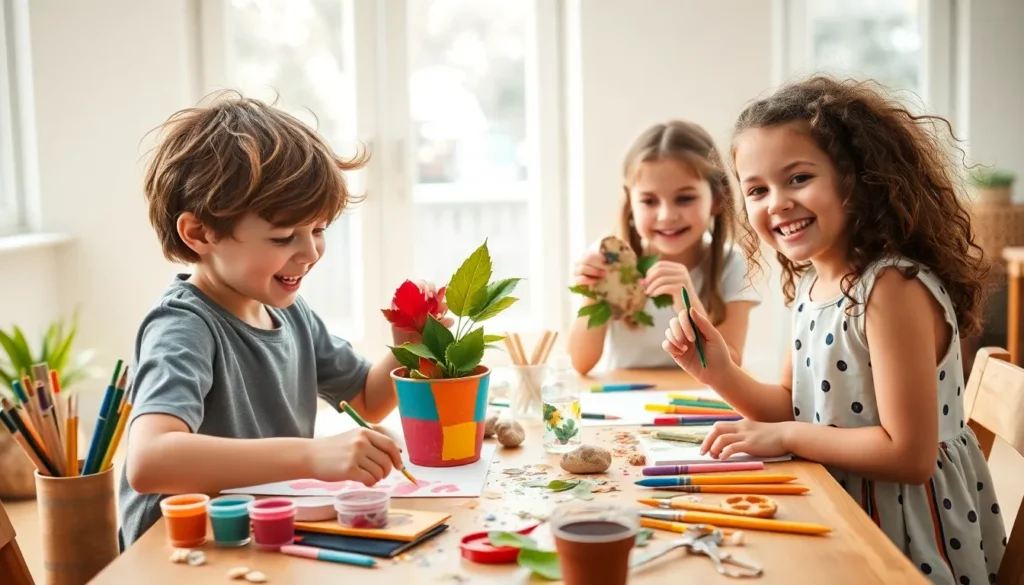In a world where screens dominate, it’s time to unleash creativity and dive into the colorful realm of DIY arts and crafts for kids. Imagine little hands covered in paint, giggles echoing as they transform everyday items into masterpieces. Not only does crafting spark imagination, but it also keeps boredom at bay—no more “I’m bored!” complaints echoing through the house!
Table of Contents
ToggleBenefits Of DIY Arts And Crafts For Kids
DIY arts and crafts offer numerous advantages for children, fostering their growth and development in various ways. Engaging in hands-on activities nurtures creativity and enhances fine motor skills.
Enhancing Creativity
Creativity thrives in children when they participate in DIY arts and crafts. Artistic activities encourage them to express their thoughts and feelings through visual and tactile means. Each project allows for personal interpretation, leading kids to come up with original ideas. Kids also learn to think outside the box, solving problems as they navigate their crafting process. Exploring different materials like paper, paint, and fabric inspires innovation, making each craft project a new adventure.
Developing Fine Motor Skills
Fine motor skills improve significantly through DIY arts and crafts. Manipulating tools like scissors, glue, and paintbrushes trains finger dexterity and hand-eye coordination. Each task—whether cutting shapes or coloring within lines—requires concentration and control. As children practice these skills repeatedly, they become more adept at performing delicate tasks in other areas of life. Engaging in crafting also builds confidence, as successfully completing projects showcases their developing abilities.
Popular DIY Arts And Crafts Ideas

Kids enjoy exploring their creativity through various DIY arts and crafts projects. Engaging in these activities fosters imagination and resourcefulness.
Nature-Inspired Projects
Crafting with natural elements connects kids to the outdoors. They can gather leaves, twigs, and flowers to create unique collages or decorative frames. Using stones, children can paint whimsical characters or patterns. Bird feeders made from pine cones, peanut butter, and birdseed serve as delightful projects that attract wildlife. These nature-inspired crafts encourage a love for the environment while promoting hands-on learning.
Recycled Materials Crafts
Recycling materials offers kids a chance to repurpose everyday items. Empty jar containers transform into colorful storage units or planters. Cardboard boxes can become imaginative spaces, like castles or houses. Plastic bottles serve as fun bases for birdhouses or garden decorations. This approach not only sparks creativity but also teaches the importance of sustainability and resourcefulness.
Seasonal DIY Crafts
Seasonal DIY crafts offer engaging projects that align creativity with the changing seasons. Kids can explore various themes by crafting items that reflect the time of year.
Summer Activities
Summer activities include building colorful wind chimes using shells and beads. Children enjoy painting flower pots to brighten up outdoor spaces. Creating homemade kites from colorful paper stimulates both creativity and physical activity. They can also assemble fun scavenger hunts where kids decorate bags to collect treasures from nature. Encouraging collaboration during these activities promotes social skills while keeping children connected to their environment.
Holiday-Themed Crafts
Holiday-themed crafts provide opportunities for kids to celebrate special occasions. Making ornaments from popcorn and string fosters hand-eye coordination. Children can design personalized greeting cards to share with friends and family. Creating spooky decorations for Halloween invites imaginative play and storytelling. Crafting wreaths from leaves and twigs enhances their connection to nature while celebrating seasonal changes. Each project encourages discussions about traditions, expanding children’s understanding of various celebrations.
Tips For Successful DIY Crafts
Focusing on age-appropriate projects ensures kids enjoy crafting while learning. Select activities that match children’s developmental stages and skill levels. Young children excel in simple tasks, such as finger painting or collage making. School-aged kids thrive on challenges like building models or crafting decorations. Matching the complexity of the project with children’s abilities enhances engagement and reduces frustration.
Safety comes first during DIY crafts. Supervision is essential when using tools and materials. Opt for non-toxic paints and adhesives to minimize risks. Position sharp objects, like scissors, out of reach when not in use. Teaching kids about equipment safety encourages responsibility and helps prevent accidents. Establishing clear guidelines for workspace organization keeps crafting areas safe and tidy.
DIY arts and crafts provide an invaluable outlet for children’s creativity and self-expression. These hands-on activities not only keep boredom at bay but also foster essential skills that contribute to their overall development. By engaging in various projects kids learn to repurpose materials and connect with nature while enhancing their fine motor skills.
The joy of creating something unique instills confidence and encourages problem-solving. As children explore different crafts they also deepen their understanding of seasonal changes and cultural traditions. Embracing DIY arts and crafts can transform ordinary moments into extraordinary memories that inspire a lifelong love for creativity.




